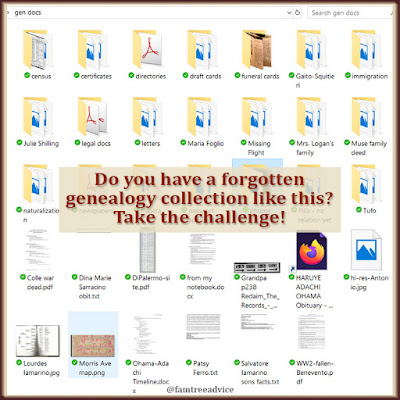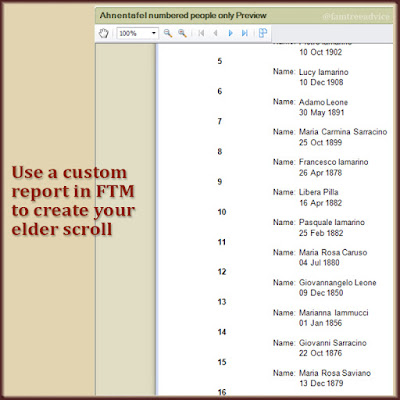Are you guilty of ignoring the tips and leads you stashed away? I am.
Years ago I put a folder on my computer desktop called "gen docs". It was a handy place to stash anything that:
- I hadn't added to my family tree yet, or
- belonged to someone who wasn't in my tree yet.
I even took the time to organize this stash with sub-folders for the different document types.
Then I moved the folder to another folder that's automatically backed up to cloud storage. That's keeping it safe. (See "How to Back Up Your Family Tree Files Automatically".) But since it's not staring me in the face anymore, it's been out-of-sight, out-of-mind for a long time.
I'm sure there are a ton of genealogy gems in that folder. Things like:
- photos of relatives I found online
- draft cards for men who weren't connected to me, but may be connected now
- vital records I photographed from microfilm (badly)
- the flight record for my Uncle Johnny who crashed and died in World War II
There's so much in that folder that past-me thought would be important to future-me. And I'm sure she was right.
 |
| This is what happens when you have a "deal with it later" folder. |
Aside from this jam-packed folder (I'll bet that phrase doesn't translate well), I also have my earliest genealogy research. It's a school notebook I filled with facts taken from ship manifests I saw on the Ellis Island website 16 years ago. It's hard to believe I ever did something so non-digital. I wish now it was a Notepad file. And I have the college paper my brother wrote about our family history in the 1970s. That paper has some stories that came straight from our grandparents. I need to capture all those gems!
What about you? What gems have you been tucking away to deal with later? Do you have death certificates you never scanned? An audio interview you never transcribed? (Guilty!) Photos you meant to digitize?
I know we like to forge ahead in our genealogy hobby. We're eager to search through the newest database. We want to try another software package that shows a lot of promise. We want to focus our energy on that brick wall.
But past-you has already laid the foundation of your family tree. What if the clue you need to break through your brick wall has been sitting in your collection all this time?
I challenge you today to a project I'm beginning right now. Go through your old notes, files, and collections. You know more about your family now than you did back then. Take a close look at each scrap of information past-you set aside and make a decision.
 |
| These documents should have gone straight into my family tree. No more procrastinating. |
Does it belong in your family tree?
- If yes, scan it, crop it, type it, and get it in your family tree. Now.
- If no, put it in another folder and make note of why you kept it and why it isn't in your family tree.
I'm starting this project by dealing with one sub-folder at a time. The "legal docs" folder has things like the sale of my grandfather's house in 1990. The "funeral cards" folder has pictures of these mementos I need to enhance in Photoshop. The "Missing Flight" folder has Uncle Johnny's flight record that I keep forgetting to put into my family tree.
There's no telling what I'll find in my stash that may:
- answer age-old questions
- establish unknown connections, or
- add a missing piece to one relative's life story.
So, yes, I challenge you and me both. Stop forging ahead for a couple of days and clean up the trail of evidence past-you created. Then tell me what genealogy gems you've discovered.




